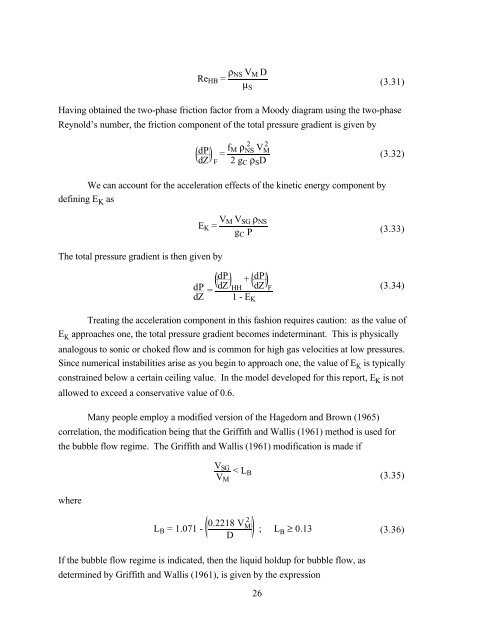multivariate production systems optimization - Stanford University
multivariate production systems optimization - Stanford University
multivariate production systems optimization - Stanford University
Create successful ePaper yourself
Turn your PDF publications into a flip-book with our unique Google optimized e-Paper software.
ReHB = ρNS VM D<br />
μS<br />
26<br />
(3.31)<br />
Having obtained the two-phase friction factor from a Moody diagram using the two-phase<br />
Reynold’s number, the friction component of the total pressure gradient is given by<br />
2 VM 2<br />
dP<br />
dZ F = fM ρNS 2 gC ρSD<br />
We can account for the acceleration effects of the kinetic energy component by<br />
defining E K as<br />
The total pressure gradient is then given by<br />
EK = VM VSG ρNS<br />
gC P<br />
dP<br />
dZ =<br />
dP<br />
dZ HH<br />
+ dP<br />
dZ F<br />
1 - EK<br />
(3.32)<br />
(3.33)<br />
(3.34)<br />
Treating the acceleration component in this fashion requires caution: as the value of<br />
EK approaches one, the total pressure gradient becomes indeterminant. This is physically<br />
analogous to sonic or choked flow and is common for high gas velocities at low pressures.<br />
Since numerical instabilities arise as you begin to approach one, the value of EK is typically<br />
constrained below a certain ceiling value. In the model developed for this report, EK is not<br />
allowed to exceed a conservative value of 0.6.<br />
Many people employ a modified version of the Hagedorn and Brown (1965)<br />
correlation, the modification being that the Griffith and Wallis (1961) method is used for<br />
the bubble flow regime. The Griffith and Wallis (1961) modification is made if<br />
where<br />
VSG<br />
VM<br />
< LB (3.35)<br />
LB = 1.071 - 0.2218 VM 2<br />
D ; LB ≥ 0.13 (3.36)<br />
If the bubble flow regime is indicated, then the liquid holdup for bubble flow, as<br />
determined by Griffith and Wallis (1961), is given by the expression

















